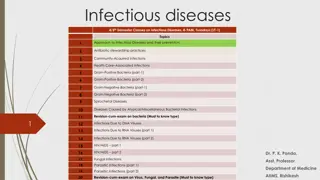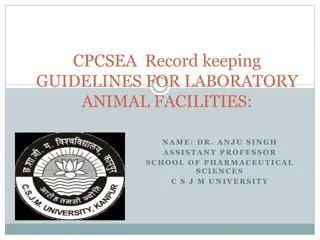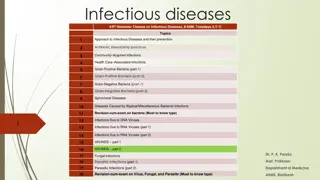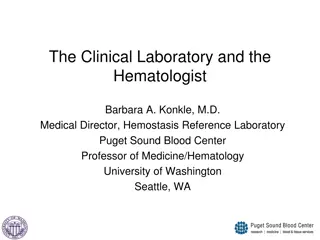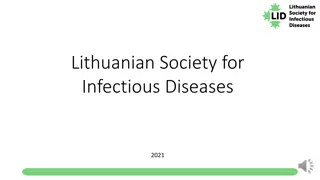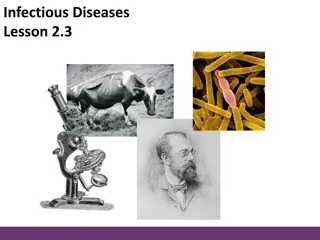Understanding Infectious Ectromelia in Laboratory Animals
Infectious Ectromelia, also known as Mousepox, is a viral disease causing high mortality in adult mice and limb amputation in surviving cases. It is characterized by skin lesions, rash, and generalized fatal disease. Various strains of the virus exist, with transmission occurring through abrasions on the skin or contaminated bedding. The pathogenesis involves invasion, replication, viremia, and spread to different organs, leading to varying outcomes in different genotypes. The disease's epidemiology is sporadic worldwide, and the mousepox model offers insights into immune system responses for research purposes.
Download Presentation

Please find below an Image/Link to download the presentation.
The content on the website is provided AS IS for your information and personal use only. It may not be sold, licensed, or shared on other websites without obtaining consent from the author. Download presentation by click this link. If you encounter any issues during the download, it is possible that the publisher has removed the file from their server.
E N D
Presentation Transcript
INFECTIOUS ECTROMELIA IN LABORATORY ANIMALS UNIT II 611 DR. SANJIV KUMAR ASSTT. PROFESSOR, DEPTT. OF PATHOLOGY, BVC, PATNA
INFECTIOUS ECTROMELIA Syn: Mousepox Infectious ectromelia is an infectious viral disease caused by mouse pox virus characterized by high mortality in adult mice and limb amputation (ectromelia) in surviving mice. Mousepox causes skin lesions, a purulent rash on the body of mice, and generalized disease, which can be fatal. It is the only poxvirus to cause disease naturally in mice.
CAUSE Family : Pox viridae Genus : Orthopox Species: Mouse pox
STRAIN There are several different types of viruses, such as NIH-79, Wash-U, Moscow, Hampstead, St. Louis-69, Bejing-70, and Ishibashi I-III. ECTV strain Moscow (Mos) - the most virulent, it was isolated by V. Sololiev and first described byAndrewes & Elford. ECTV strain Naval (Nav) - isolated from an outbreak in a US naval research facility, which manifested as a lethal disease in BALB/c mice and a mild disease with low morbidity and mortality in CD-1 mice
EPIDEMIOLOGY The disease has spread throughout the world, but its occurrence is sporadic and rare. There are several named strains of ectromelia virus that vary in virulence, including NIH-79, Wash-U, Moscow, Hampstead, St. Louis-69, Bejing-70, and Ishibashi I III. The mousepox model presents an opportunity to study the components of the immune system that are required for an efficient immunological response to a natural poxvirus infection in a well-understood animal model that can be further manipulated bytargetedinactivation or expression of genes.
TRANSMISSION No vertical transmission Infection transmitted alimentary, aerogenic, contact ways. It is believed that the natural route of infection occurs through abrasions on the skin, which means that the transmission of the virus occurs from animal to animal or through fomites, such as infected bedding in the place for keeping mice. Through cutaneous trauma
Pathogenesis: Invasion of skin or mucus membrane and local replication Spread and replicate in the regional lymph nodes Primary viremia Reach and replicate in liver and spleen Secondary viremia Susceptible genotype Resistant genotype Intermediate genotype Develop disseminated infection Develop limited infection Develop disseminated infection Death within hrs and shed little virus Recovery before shedding virus Survive long enough to spread virus to others Intermediately susceptible animals Virus disseminated into various organs Skin Payers patches Liver Spleen Lymphoid organs Rashes and gangrene formation in limbs Amputation Necrosis Necrosis Necrosis and scaring of red white pulp Necrosis Hemorrhagic enteritis pattern Mosaic
CLINICAL SIGNS The severity of the disease and the outcome are determined by factors such as the strain ofthe virus,thegenotype,aswellas thedose androute ofinfectionofthe virus. Animals of all ages are sensitive to the disease, however, all sensitivities of different mouse linesaredifferent. Existing resistant strains of mice, such as C57BL / 6, C57BL / 10 and AKR, may not have clinicalsignsthatviruses cancauseforotheranimals. It is important to note that the genetic background of the mouse can affect the infection, which means that host factors are involved in the regulation of susceptibility and resistance to the virus. For example, wild mice exhibit variable susceptibility, while laboratorystrainswere useful fordetermining hostresistancefactors.
The disease can occur latent, acute and subacute. Animals with a latent form of the virusdo notshow anysigns of disease. In this case, infection can be activated by various factors, for example, during irradiation, transportation, infection with other pathogens, and experimental load. With a fulminant form, clinical symptoms do not have time to manifest, and the death of mice occurs unexpectedly andfast.
The subacute form represents the classical form of ectromelia : in such cases in animals, mainly onthe head, tailandlegs develop skin lesions. The skin is edematous, hyperemic, with small focal hemorrhages, which are covered with dry crusts. Subsequently, on the fingers, ears and tail, foci of necrosis are formed, covered with dark browncrusts, which then disappear. Sometimes amputation of limbs or phalanges of the fingers and tail occurs, thus the nameectromelia given tothis virus.
In acute cases ruffled fur or prostration may occur for only a few hours before death. Mice that survive acute infection may develop chronic disease characterized by a focal or generalized rash anywhere onthe body Conjunctivitis alsomayoccur. Skin lesions usuallyrecede within several weeks, buthairless scarsmayremain. Additionally, severe viral infection of the feet and tail during the rash syndrome can lead tonecrosis andamputation
GROSS LESIONS Externally conjunctivitis, alopecia, cutaneous erythema and erosions (rash), and swelling anddry gangreneofextremities, which resultin ectromelia Livers swollen, friable, and mottled with multiple pinpoint white to coalescing necrotic foci Spleen shows necrosis and scarring of red and white pulp can produce a macroscopic mosaic patternofwhiteandred brown Necrosis of thymus, lymph nodes, Peyer s patches, intestinal mucosa, and genital tract alsohavebeen observed during acute infection Severe intestinalinfectionmaybe accompaniedby hemorrhage.
HISTOPATHOLOGY Focal coagulative necrosis in the liver, spleen, lymph nodes, Peyer s patches, and thymus,aswell asother organs. Skin lesions consist of focal epidermal hyperplasia, with hypertrophy and ballooning ofepithelial cells A type (Marchal body) acidophilic intracytoplasmic inclusions in Epithelial cells of skin ormucousmembranes Btypeof basophilic intracytoplasmic inclusion in all ectromelia-infected cells
PREVENTION AND TREATMENT To avoid infection of the colony with the virus of electromelia, it is necessary to regularly test the colony andmonitor the health ofmice. To eradicate the virus in the colony, quarantine must be established and reproduction stopped. Vaccination also helps eliminate the problem of virus infection.
The animal house must be thoroughly cleaned and disinfected, preferably with gaseousformalin or vaporized hydrogen peroxide. Ectromelia virus can survive for 11 days at room temperature in blood. All other animal house materials should be discarded as hazardous waste (incinerated) or autoclaved. Autoclaving, formalin treatment, and common disinfectants will inactivate the ectromelia virus, aswill desiccation ordetergents.









